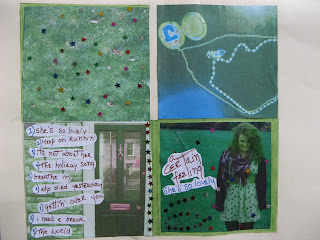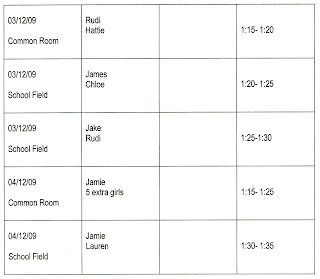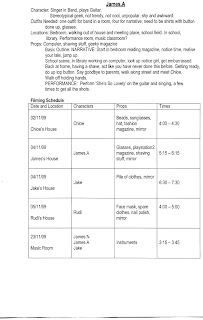Evaluation film script
Introduction of names and titles. Project lead etc.
Niall – Project lead and creative director
Jordan
Nash
Lewis
In what ways does your media product use, develop or challenge forms and conventions of real media products?
Niall – Our video is a narrative based movie about a young couple and their relationship.
When we first set about producing our video, very early into the process, we made it a big priority to play to our strengths and keep within our limits. This meant that even though we may have wanted to produce a very stylish video using a lot of special effects, difficult camera operations and complex narratives, it was smarter to use a more simplistic approach and make a video that was well made and good to watch rather than an ambitious but heavily flawed attempt at a professional grade video.
Jordan – Because of this we researched into music videos and focused heavily on researching into things that would be achievable to us under our restrictions. For example, we looked at how we could effectively convey emotion, something we wanted to achieve, without the need for complex camera operations and lots of special effects and professional grade equipment.
Niall – One of the most recognisable places this is seen is in our narrative. The story of a young couple breaking up, coming to grips with being alone and eventually meeting again is nothing new and not original in any sense. What this did allow us to do however is create a good, solid narrative that we knew would work. However, producing a narrative like this allowed us to focus more on the overall quality of our video instead of making sure our ambitious plans came to fruition.
I think we’d all agree that this paid off, as you can see in the following clip.
Here you’ll see a short clip from our video, followed by a clip from The Killers original video for When You Were Young, which we closely examined for our own work.
Play video 1 – introduction (our video then Killers)
Nash – As you can see, there are many similarities with our video and the original. We kept the concept similar but toned it down to play within our limits. From the clip you can see that we kept the camera angles simple and focused more on creating an emotional scene rather than a complex one. The main problem with it is the fall, which looked planned and amateur, but sadly it’s the best we could get.
Lewis – Although we kept close to existing conventions we did add our own originality to the video. As you can see from the following extract.
Play video 3 – woman sequence (our video then Killers)
As you can see, although the idea of a woman in distress isn’t original, the way we shot this scene and edited it is, and our own originality went into the creation of this scene, as well as the rest of the video. By doing this, we were able to create an original and high quality video without breaking boundaries.
Jordan – Although we kept close to the conventions found in narrative based videos, we did go against them in ways and our video is a strong contrast to concept based music videos.
Nash – As you can see from the following clips, our video is greatly different to that of The Red Hot Chilli Peppers video for Can’t Stop, which is a concept based movie.
Play video 6 – Conceptual scene (our video then RHCP)
Play video 5 – Band sequence (our video then RHCP)
Niall – Clearly here we have used our own ideas for the staging of the band sequences and have stayed far away from the concept based conventions that our used in the video for can’t stop. The pace of our video is evidently slower with camera shots staying for longer than in the can’t stop video and with fewer unique angles, again chosen to play to our strengths.
As well as this, our video and narrative relate more to the lyrics than the concept based videos do and this again helps us stay within our limits by creating a powerful video without the need for an extravagant set, much like the one seen in the video for can’t stop.
Overall I think our video is a success. We stayed close to existing conventions but also used our own ingenuity when it came to planning, shooting, editing and finalising our production. We also used our research effectively to work out what would aid us the most in our production, whilst also being ambitious in other aspects of our work to make sure we got the most out of the production that we could of.
How effective is the combination of your main product and ancillary texts?
Niall – When producing our ancillary tasks we made sure that they related to our video, both in terms of continuity but also in the atmosphere and mood of our narrative and video on the whole.
We decided to produce a CD cover (both front and back) and a full page magazine advert. We chose those two because the CD cover would obviously go well with a music video and with what was meant to be the bands promo single, and the magazine advert made sense due to the logical steps that would happen if you were to market a band in this manner.
As a team we designed the look and feel of the pieces and being the most artistic person on the team I took up the task of producing the pieces using Adobe Photoshop CS4 and other products when needed.
Lewis – For the CD cover I took photographs on the covering band against a white backdrop and edited them into another scene, using photographs of old alleyways and stock textures taken from resources websites. The same technique was used for the magazine advert but changes were made where necessary and I went with a different colour palette for a more diverse look.
Jordan – I think the pieces suit our main product well due to their style, visual elements and the atmosphere they create. Our video is all about drama and emotions, focusing on heartbreak, sadness and anger and I think the CD cover and advert reflect this. When looking at all of them together the moods of all the pieces complement each other and most importantly the ancillary pieces look like they belong with the video instead of looking like a quick add on or cheap, unrelated extra.
Nash – Perhaps the biggest problem with our ancillary pieces is that they aren’t focused on a lot and aren’t considered much when looking at the video. In all the feedback we’ve received and whenever we show the video the cover and advert aren’t shown and this makes them more of a background gimmick than I would have liked. They are still important parts of the portfolio, but they aren’t given the same focus and this can affect the view on them and their relation to the video.
What have you learned from your audience feedback?
Niall – From the various feedback we’ve received the consensus on the whole is that the video is of a good quality and everybody we’ve asked has liked it and enjoyed watching it.
Many of the critiques stated that they liked the use of different camera angles and thought that they added to the drama and atmosphere of the video. The reviewers also said that they liked the quiet lines of song at the start, saying that it added a nice touch to the video. Another aspect some of them liked was the use of a circular narrative in which we repeated the fall at the start and end of the video. However, a main concern was that the quality of the fall was poor and badly handled, something we would agree with as it was the hardest and poorest part of the video to shoot.
Nash – As well as some of the reviews being from local sources, we sought some opinions from impartial sources and managed to get a graduating film student to comment on the video.
The film student’s opinion was really valuable and his critique, being closer to a professional analysis than the others, made it very useful to us. In his critique he mentioned not only the good and bad things but also went into more depth (for example, mentioning colour correction and technical aspects the others didn’t) and this made it a more useful to us when analysing and evaluating.
Lewis – One of the biggest flaws people had with our video was the lip-syncing of the band sequences. Due to the covering band not playing exactly with the music there are times when the audio and visuals don’t match and people noticed this as a prominent error, more than we thought they would.
A lot of the critiques also praised the narrative, stating that it was of a good length and complemented the band sequences well. They also mentioned that it made good sense and showcased a lot of emotion, something that was a main aim of ours which we were glad to achieve.
Jordan – On the whole the critiques were very positive and strongly supported our view of creating a simple yet high quality video. The aspects the reviewers had trouble with were ones we knew about and couldn’t change and the points we tried to convey with our video were fully realised which was very affirming for us.
How did you use media technologies in the construction and research, planning and evaluation stages?
Nash – Media technologies played a large part in the creation of our music video and in the other parts of our portfolio; from the research stages to the ancillary tasks and in the way we sought feedback. The rise in digital technology available to us had a big influence on how our work progressed and how the final product looked.
Niall – In the actual production of our music video we used various media technologies in a number of ways to bring about our finished piece. A large improvement for us was the use of HD video recording equipment to better the quality of our video and to make it easier to edit and finish. The camera we used (Fujifilm S2000HD) made shooting the video a lot easier because of its enhanced features; such as better zoom, higher optics and the possibility to use filters whilst filming. Also, unlike older cameras and those recording onto mini-DV tapes, the videos were saved into digital files, making them easier to transport, copy, back-up and most importantly, use.
Lewis – As well as the recording equipment we had greatly improved editing facilities available to us as well. Thanks to the rise in professional grade products becoming available to consumers we were able to use Sony Vegas editing software, which helped us a lot in the final stages of production. The program was filled with features and add-ons, including a large bank of presets and installed plug-ins, giving us a variety of transition and video effects to include if needed. The program also used a semi-professional layout for editing, including a multi-layered setup which allowed us to overlay video and audio as well as add filter effects and transitions whilst keeping everything clear, separated and easily found. It would’ve been a much harder task to edit our video using another, less professional program, as we wouldn’t have had the resources available to us that we had to include.
Jordan – Media technologies also played a big part in how we shared our video for feedback purposes. The ability to upload media to the internet, using various websites as hosts (most notably www.youtube.com), allowed us to quickly and easily share our video with online viewers for quick access and an easy way to receive feedback through the use of comments and tags.
Although media and digital technologies were mostly used for the production of our video, they also played a big part in the creation of our ancillary tasks, most notably the CD cover and magazine advert. Using Adobe Photoshop CS4 I was able to create pieces of work that looked professional and matched the atmosphere we wanted to create with our video. Media technologies allowed us to quickly and efficiently create these pieces of work and share them online for the purposes of feedback.
Niall – Also, as well as the major aspects of our portfolio, media technologies also aided us in our research. Using online facilities, such as search engines and stock websites, we were able to gain more insight into music videos and the select areas we studied further in. We also had a higher level of information which was widely available, making this stage of our project a lot easier.
Throughout our project we used media technologies a lot and this had a big impact on the creation and finish of our portfolio. Without such facilities our portfolio would have been of a much poorer quality in many aspects of its creation.
Conclusion –
Niall – So there it is. Overall we all thought the video was a great success and we were pleased with the final result. The criticisms we received were a big help to us and we were especially thankful to the rises in digital technology that helped us a lot in our production.
Group members (and candidate numbers)
Niall Lucas – 3125
Jordan Perrett – 3161
James Nash – 3148
Lewis Taylor - 3206
.PNG)



















































